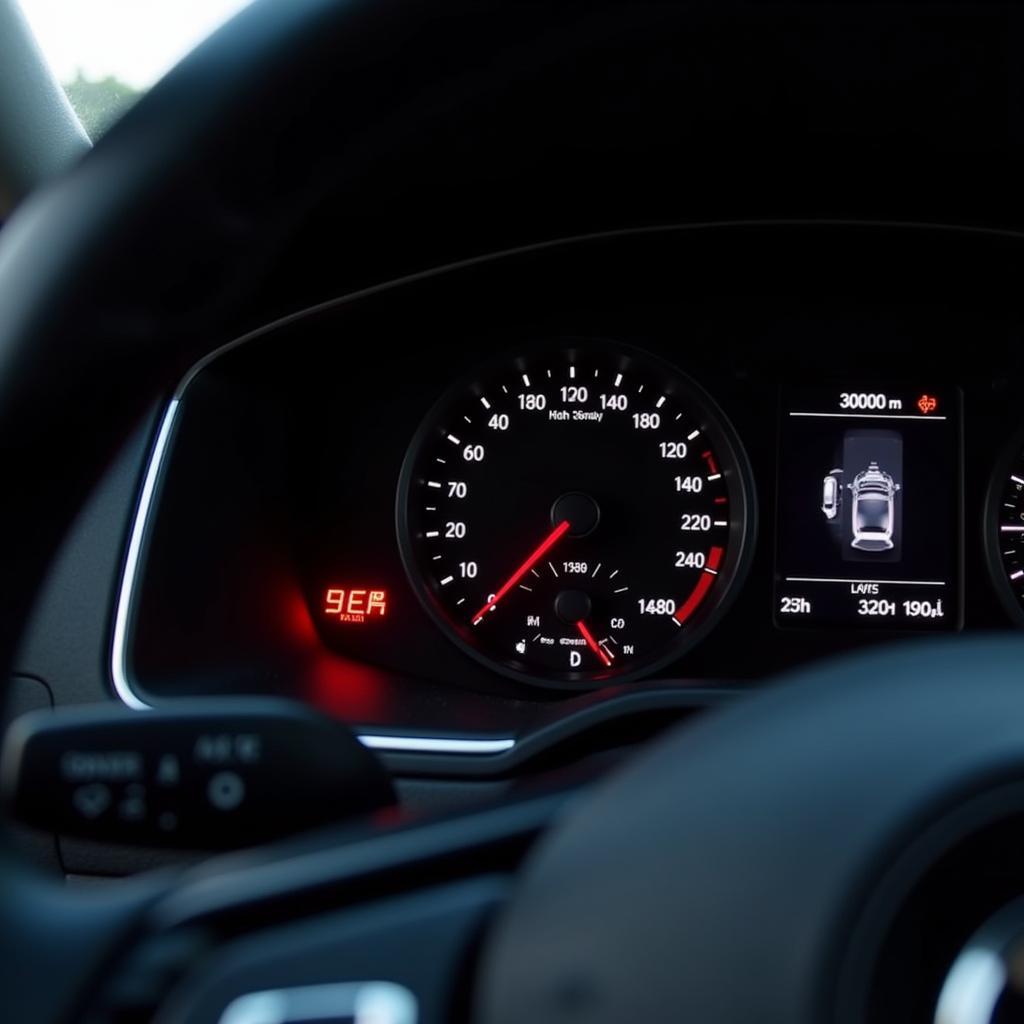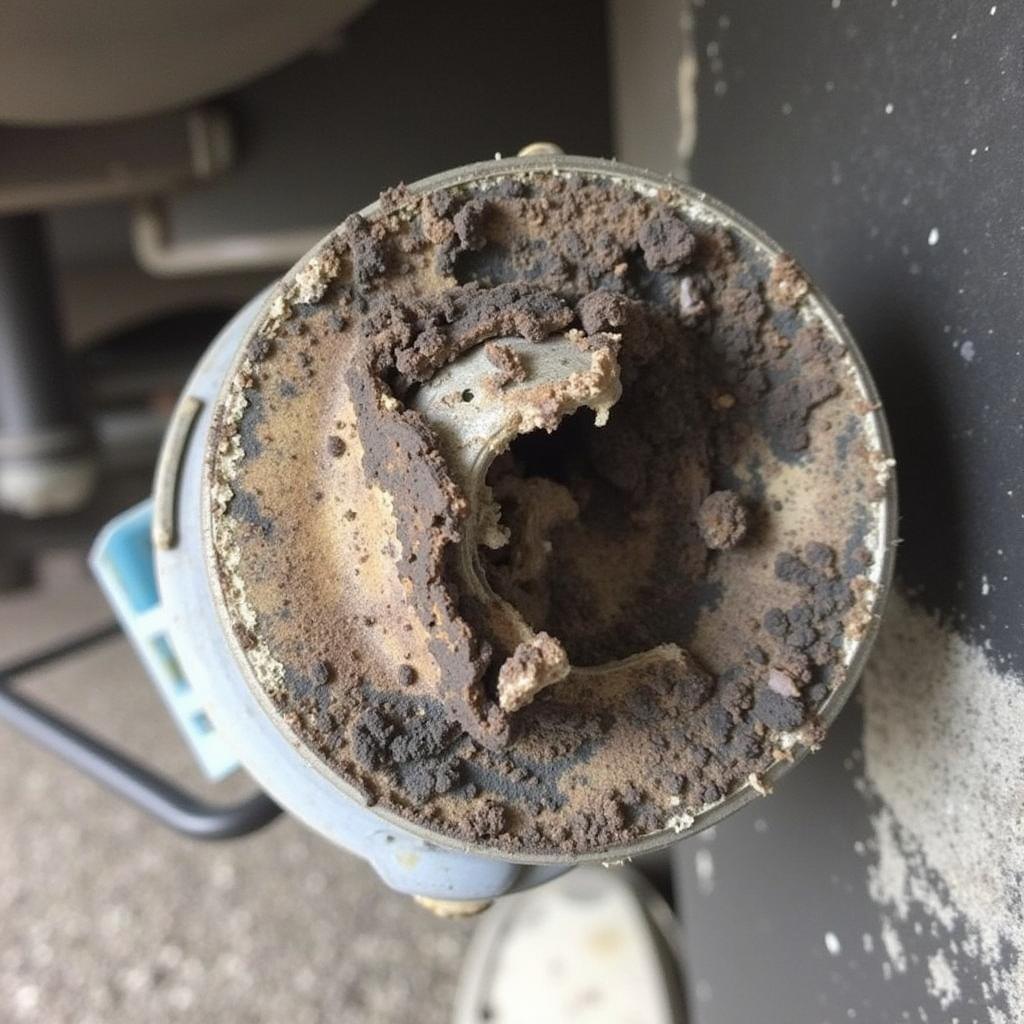The brake pad warning light on your VW Golf is a crucial safety feature, illuminating when the brake pads wear down and require replacement. Ignoring this warning can compromise braking performance and lead to costly repairs. This comprehensive guide will help you understand the causes behind a VW Golf brake pad warning light and provide effective solutions to address the issue.
One of the most common reasons for the brake pad warning light to appear is, of course, worn brake pads. However, there can be other culprits, such as a faulty brake pad sensor, low brake fluid, or issues with the braking system itself.
 VW Golf Dashboard Showing Brake Pad Warning Light
VW Golf Dashboard Showing Brake Pad Warning Light
Understanding Your VW Golf Brake Pad Warning Light
The brake pad warning light is designed to alert you about potential problems with your VW Golf’s braking system. Typically, it illuminates as a yellow or red symbol on the dashboard and may be accompanied by a message such as “Brake Pad Wear.” Understanding the different warning light colors and messages can provide valuable insights into the severity of the issue.
Common Causes of VW Golf Brake Pad Warning Light
While worn brake pads are the most common cause for the warning light, several other factors can trigger it. Here’s a closer look at some of them:
-
Worn Brake Pads: Brake pads are designed to wear down gradually with use. As they wear down, the brake pad wear sensor, a small metal tab embedded within the pad, comes into contact with the brake rotor, completing a circuit and illuminating the warning light.
-
Faulty Brake Pad Sensor: The brake pad sensor itself can malfunction due to corrosion, damage, or improper installation. If the sensor fails to send the correct signal, the warning light may illuminate even if the brake pads are in good condition.
 Close Up of a Faulty Brake Pad Sensor in a VW Golf
Close Up of a Faulty Brake Pad Sensor in a VW Golf
-
Low Brake Fluid: Low brake fluid level can also trigger the brake pad warning light. This is because the brake system relies on hydraulic pressure to function correctly, and insufficient fluid can compromise braking performance.
-
Brake System Issues: In some cases, the warning light may indicate a more serious issue within the braking system itself, such as a problem with the ABS (Anti-lock Braking System), brake master cylinder, or brake lines.
Diagnosing the Problem
To effectively address the brake pad warning light on your VW Golf, it’s crucial to accurately diagnose the underlying cause. Here are some steps you can take:
-
Check the Brake Pads: Visually inspect the brake pads for wear and tear. If they appear thin or worn down, it’s time for a replacement.
-
Inspect the Brake Pad Sensors: Examine the brake pad sensors for any signs of damage, corrosion, or improper installation. If the sensors are faulty, they will need to be replaced.
-
Check the Brake Fluid Level: Locate the brake fluid reservoir under the hood and check the fluid level. If it’s low, top it off to the recommended level using the appropriate brake fluid type.
-
Seek Professional Diagnostics: If you’re unable to diagnose the problem yourself or suspect a more complex issue, it’s best to seek professional diagnostics from a qualified mechanic or dealership.
Solutions for a VW Golf Brake Pad Warning Light
Once you’ve identified the root cause of the warning light, you can take the appropriate steps to address the issue:
-
Brake Pad Replacement: If the brake pads are worn, replace them with high-quality replacements specifically designed for your VW Golf model.
-
Brake Pad Sensor Replacement: Replace faulty brake pad sensors with new ones to ensure accurate wear detection.
-
Brake Fluid Top-Up or Flush: Top up the brake fluid if it’s low, or perform a complete brake fluid flush if the fluid is old or contaminated.
-
Professional Repair: For complex braking system issues, seek professional repair from a qualified mechanic or dealership.
Preventative Maintenance for Your VW Golf’s Brakes
Regular brake system maintenance is essential for optimal safety and performance. Here are some preventative measures to keep in mind:
-
Regular Brake Inspections: Schedule routine brake inspections with a qualified mechanic, especially before long trips or at least once a year.
-
Timely Brake Pad Replacement: Don’t ignore the brake pad warning light. Replace worn brake pads promptly to prevent further damage and ensure optimal braking performance.
-
Brake Fluid Flush: Flush and replace the brake fluid every 2-3 years or as recommended by your VW Golf’s owner’s manual.
 Mechanic Replacing Brake Pads on a VW Golf
Mechanic Replacing Brake Pads on a VW Golf
Conclusion
The brake pad warning light on your VW Golf is a crucial safety indicator that should never be ignored. By understanding the common causes, diagnostic steps, and solutions outlined in this guide, you can address the issue promptly and ensure optimal braking performance and safety for your vehicle. Remember, regular brake system maintenance is key to preventing issues and enjoying a smooth and safe driving experience.
